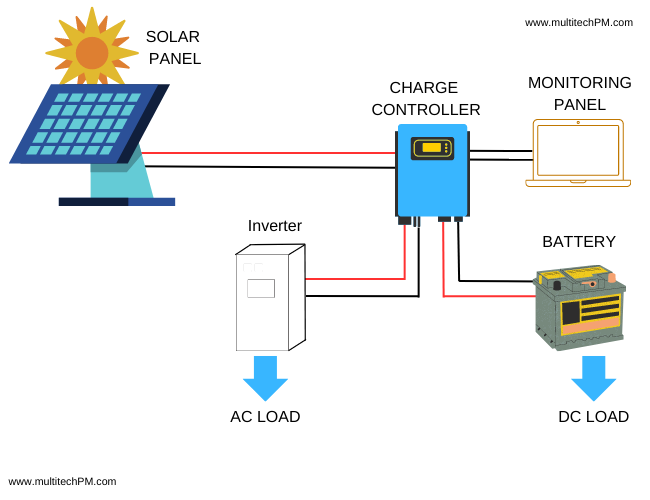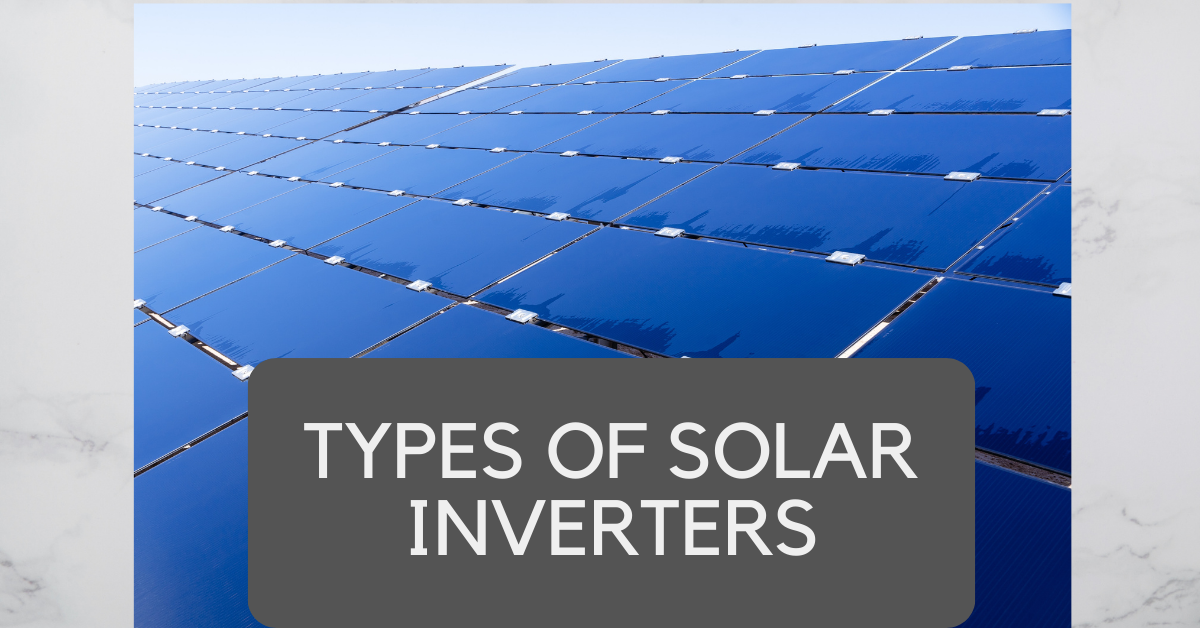In this article, we will learn about the types of solar inverters, its advantages and functions.
In the quest for harnessing the boundless power of the sun, understanding the intricate components of solar energy systems is paramount. At the heart of every solar setup lies a remarkable piece of technology – the solar inverter. These unassuming devices play a pivotal role in converting sunlight into the electricity that powers our lives. In this enlightening exploration, we delve into the captivating realm of solar inverters, uncovering the various types, their unique functionalities, and the transformative impact they have on the world of renewable energy. Whether you’re a seasoned solar enthusiast or just embarking on your solar journey, this guide will shed light on the essential components that make solar energy a shining beacon of sustainability.
The provided image offers a comprehensive view of the various components within the electrical system. It’s essential to focus on the solar inverter’s positioning and its role within this intricate system configuration. Understanding where the solar inverter fits into the scheme is crucial for grasping how it transforms solar energy into usable electricity, enabling homes and businesses to tap into the power of the sun.
To learn more about all of the components please follow check out this article.

Table of Contents
What is a Solar Inverter?
At its core, a solar inverter is the conductor of the solar energy orchestra. In very simple words, it transforms DC to AC. It takes the direct current (DC) electricity generated by solar panels and orchestrates its transformation into alternating current (AC), the form of electricity used in our homes and industries. As an additional point, you have the option to plan your home with DC outlets, allowing you to directly utilize electricity from the batteries or solar panels without any intermediate conversion.
Types of Solar Inverters
String Inverters
A string inverter system groups the power generated by sets of solar panels into “strings.” These strings of panels are then connected to a single inverter, where the electricity is transformed from DC (direct current) to AC (alternating current).
Advantages: String inverters are the stalwarts of residential solar setups. They’re cost-effective and straightforward to install. Due to their configuration, where panels are connected in a “string” and linked to a single inverter, string inverters are well-suited for smaller solar installations.
Considerations: They are sensitive to shading, meaning if one panel is shaded or malfunctioning, it can impact the performance of the entire string.
When assessing string inverters, consider several key factors. Firstly, efficiency is vital, as it influences the overall system’s effectiveness and energy production. Higher efficiency string inverters minimize energy loss during the DC to AC conversion. Secondly, take into account the size of the inverter, which should align with your solar array’s size, location, and specific requirements. Larger inverters may come at a higher cost but can maximize energy output. Additionally, review product warranties, ensuring they match your solar panel warranties to cover defects and environmental damage. Finally, while string inverters are not the priciest part of a solar system, weigh the cost against their efficiency, size, and warranty, as larger, more efficient inverters may be a worthwhile investment compared to other options like power optimizers or microinverters.
Microinverters
As mentioned above for string inverter setups, solar panels are connected in a series, and their collective performance relies on the least efficient panel in the group. Conversely, microinverters are positioned behind each individual solar panel within your array rather than being centralized near your fuse box. This arrangement allows each panel to operate independently, optimizing energy production regardless of the performance of other panels in the system.
Advantages of micro-inverters include enhanced energy conversion at the panel level, suitability for complex roof designs and shading-prone areas, efficient energy production in smaller systems- this is because each solar panel has its own microinverter, allowing them to function independently, individual panel monitoring, robust performance in shading scenarios, and extended warranties usually lasting 25 years. However, they come at a higher cost compared to string inverters and power optimizers and can be more challenging to access for repairs due to their rooftop and under-panel installation.
Hybrid Inverters
A hybrid solar inverter is an all-in-one device that combines the functions of both a solar inverter and a battery inverter. It’s designed to efficiently handle and manage power from your solar panels, solar batteries, and the utility grid simultaneously, offering intelligent and seamless power management for your energy needs.
A standard grid-tie solar inverter converts DC electricity from your PV system into AC electricity. On the other hand, a battery inverter transforms DC electricity stored in your solar battery into usable AC electricity. A solar hybrid grid-tie inverter combines these functions in one unit, enhancing traditional solar inverter operations. Moreover, it can draw power from the grid to charge your battery when solar power generation is limited due to weather or seasonal changes, ensuring continuous energy supply.
Advantages: Hybrid inverters are the versatile jugglers. They not only convert DC to AC but also manage energy storage, making them perfect for homes or businesses with battery systems. They enable self-consumption of solar energy and provide backup power during grid outages.
Considerations: Installation and maintenance can be more complex due to their dual functionality.
Central Inverters
Central inverters are designed to consolidate the power generated by a solar plant into a central location. They employ string combiners to interconnect wires from individual solar panels, with a subsequent combiner gathering the combined output from these strings. This accumulated output is then directed into the central inverter for conversion into usable electricity.
Central solar inverters are typically installed close to the primary electricity service switchboard in a protected environment, ensuring resilience to harsh climate conditions. These inverters aggregate all the DC terminals from the solar panels into a combiner box input, and the resulting output is then channeled to the central solar inverter. This configuration allows a single, high-capacity inverter to manage the entire solar array, distinguishing it from string and micro solar inverters, which have lower power capacities and handle smaller subsets of the system.
Central inverters offer several advantages. They are cost-effective as fewer inverters are needed per site, making them an economical choice. System backup and restoration can be swiftly executed when necessary. More reliable as this is placed in a closed environment protecting it from external conditions thus less damages. The cost per watt is optimized in central inverters, rendering them the most budget-friendly option. Monitoring is simplified in large projects due to fewer inverters. Moreover, central inverters have the capability to generate higher power. However, they are not recommended for smaller sites due to their substantial power capacity and complexity. Repairing central inverters necessitates technical expertise and they are less serviceable. Additionally, if one solar panel malfunctions, it impacts the entire system’s output.
Conclusion
Solar inverters serve as the bridge between sunlight and electricity, ensuring that the power generated by your solar panels is seamlessly integrated into your daily life. The choice of the right inverter for your solar installation depends on various factors, including your energy needs, budget, and environmental conditions.
As a responsible citizen of this planet, you’re at the forefront of understanding and embracing the potential of clean and renewable energy. Solar inverters are not just technological marvels; they are key players in reducing carbon emissions and building a sustainable future. Embrace the power of solar energy and make a positive impact on the planet.
Check out this post to learn more about advantages of using solar.

